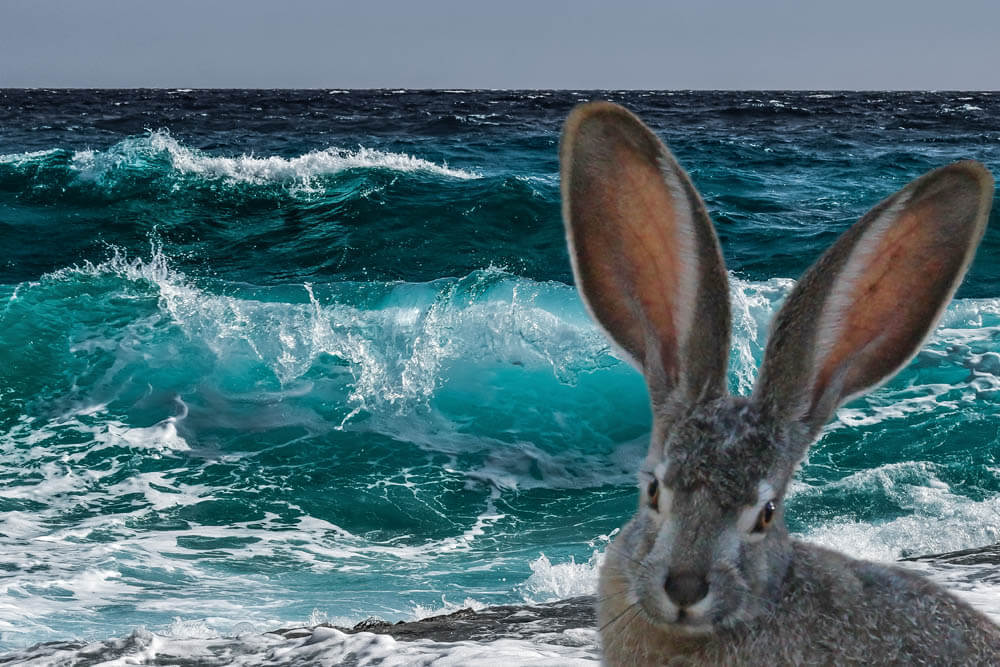For many terrestrial mammals, swimming is a survival instinct. We may not all love swimming, but we all evolved to recognize that moving our arms and legs while in the water can help us stay afloat and survive.
Thus, the short answer to the question “can rabbits swim?” is yes, they definitely can.
However, the reality is far more complicated than that. While rabbits are indeed capable of swimming, most don’t like it. In fact, swimming can be dangerous for some breeds.
Differences also exist between wild and domesticated rabbits, with the latter generally finding the activity less favorable. The only water our pets should be exposed to is the drinking water in their water bowls.
Read on to know more about rabbits and swimming!

Swimming is Natural for Rabbits
Rabbits evolved with the ability to swim for one simple reason: it helps them survive in the wild. If a predator chases a wild rabbit to the edge of a pond, for example, the rabbit could jump into the water to get away from it. Small wonder these animals can swim within one to two weeks of birth.
Other species of wild rabbits evolved to be at home in wet environments. For marsh rabbits and swamp rabbits, for example, swimming is a part of their daily routine. Researchers have even observed such bunnies playing with one another while swimming, a clear indication that they enjoy being submerged in water.
Domesticated rabbits aren’t the same as wild rabbits, however. True, our pet bunnies inherited the ability to swim from their wild ancestors, but as swimming isn’t a necessity for them, they’re not as keen on the activity. With that in mind, let’s explore how domesticated rabbits feel about swimming.

7 Major Reasons Why Domesticated Rabbits Don’t Like Swimming
Our selective breeding of domesticated rabbits has given these animals characteristics that make them ill-suited to swim. They therefore experience much stress and anxiety when swimming, which explains why they’d rather stay on dry land.
Let’s take a closer look at why domesticated rabbits don’t like swimming.
1. They’re not used to large bodies of water
A vast majority of rabbits that have been bred in captivity have only known life on land. Thus, while they do retain the ability to swim, they don’t particularly enjoy it. They may also not know how to breathe properly during the activity, causing them to accidentally inhale water, which can harm their lungs and result in drowning.
Even a simple bath under running water can cause a rabbit distress. Fortunately, bunnies are naturally clean animals that groom themselves regularly, meaning you have no need to wash them.
2. They have plush coats
Selective breeding has given our pet bunnies plush coats. These absorb excess water, which weighs them down, making swimming that much more uncomfortable, difficult, exhausting, and even dangerous. Imagine yourself swimming in a suit, dress, or thick woolen coat, and you get the idea.
3. They have trouble regulating their body temperature
Because domesticated rabbits can’t regulate their body temperature effectively, spending time in the water can make them intensely cold. In severe cases, their internal temperature can drop to dangerous levels to cause hypothermia, which can be life-threatening if left untreated.
4. They have sensitive skin
Domesticated bunnies have sensitive, fragile skin. A sudden change from dry to wet (and vice versa) can therefore cause a pet rabbit skin irritation, leading to much discomfort.
To relieve said discomfort, a bunny may then vigorously scratch itself until the skin breaks, causing wounds and possibly infection. It could even lead to the thinning or loss of fur.
The chlorine in swimming pool water is a particularly harsh irritant, so never make your pet swim in a public or private pool.
5. They have small lungs
As tiny animals, rabbits have tiny lungs, so inhaling even a small amount of water can cause them pain. And the more water they inhale, the more likely they are to drown.
Even if your pet survives a near-drowning incident, its anatomy puts it at an increased risk of succumbing to secondary drowning.
6. They may panic in the water
As mentioned above, domesticated rabbits aren’t used to swimming. So if you suddenly put your bunny in the water, it may end up panicking due to the shock of being forced into an unfamiliar and scary situation. The frantic behavior induced by panic can, in turn, increase its chances of injuring itself or drowning.
If you regularly make your rabbit swim, it may become stressed and anxious – mental health issues that, if prolonged, can contribute to the deterioration of a rabbit’s overall health. In other words, the more you force a swimming-averse rabbit to swim, the greater the chances of it growing ill and dying prematurely.
7. They have a hard time grooming wet fur
So you’ve managed to get your bunny out of the water. Is its suffering over? Not quite.
Rabbits find it challenging to groom their wet fur, especially because it tends to knot. In the worst-case scenario, you might have no choice but to use scissors to cut sections off your rabbit’s fur to get rid of those stubborn tangles.

Should You Make a Domesticated Rabbit Swim?
Because swimming can cause a pet rabbit intense discomfort, we highly recommend not making your rabbit swim. Don’t submerge your rabbit in a sink or bathtub full of water. Never throw it into a pool, pond, or any other large body of water. And if it does end up in the water, pull it out as quickly as you can before it panics and unintentionally draws water into its lungs.
Natural sources of water such as ponds may also contain a variety of microorganisms that can threaten a rabbit’s health. Tiny creatures such as tadpoles and fish can bite, while the accidental ingestion of animal refuse such as bird droppings can cause illness or disease. And let’s not forget that there could be chemicals in the water that may be toxic to bunnies.
The sea exposes your rabbit to even more dangers, including snakes, crabs, and larger fish. Remember, rabbits are completely helpless in the water and won’t have any way to defend themselves from such creatures.
Swimming pools are especially dangerous, as these structures don’t offer rabbits easy ways to climb out of the water without help from their owners. If left alone to fend for itself, a rabbit in a pool can paddle itself to exhaustion, at which point it can end up drowning. And as we mentioned above, the highly irritating chemical known as chlorine is present in swimming pool water.
Bathtubs and toilets can contain a range of chemicals, some of which are toxic to bunnies. Bleach, for example, is extremely hazardous to these creatures.
Drying a wet rabbit and helping it recover
Once you’ve returned your pet to dry land, wrap it in a towel, then gently but thoroughly rub its fur until it’s completely dry. Avoid using a blow dryer, as this can frighten a rabbit as well as irritate its delicate skin.
Non-scary external heat sources can work wonders, however, so consider gently pressing a hot water bottle against its body. This will warm its body up and even help in the drying process.
Depending on what kind of water your bunny went swimming in, you may have to seek veterinary help. A trip to the vet is a must if you notice your pet having respiratory problems (such as coughing and breathing difficulty) or if it later starts exhibiting symptoms of illness (such as diarrhea, vomiting, lethargy, and the like).
At any rate, call an animal hospital or clinic to ask a rabbit expert for advice on what you should do to help a rabbit that spent some time in the water. If necessary, rush your pet to the vet; they’ll have it undergo x-rays and other tests to determine if it’s sustained any significant harm, then provide it with the appropriate treatment(s).

FAQs About Rabbits and Swimming
Let’s answer a few more questions about rabbits and swimming!
Do rabbits have webbed feet?
Yes, they do. However, this feature isn’t used for swimming but for hopping and running.
Is aquatherapy good for rabbits?
Aquatherapy, a.k.a. swimming therapy, is one of the rare occasions where swimming is beneficial for bunnies, as it can help those with arthritis or other types of joint issues. It also introduces the animal to water in a limited and controlled environment, which can help reduce the rabbit’s discomfort with the activity.
Before having your bunny undergo aquatherapy, however, we suggest seeking advice from a rabbit veterinarian, as they can determine whether this is the ideal treatment for it.
Do all domesticated rabbits hate swimming?
Like people, every domesticated rabbit is unique, with distinct personalities and preferences. So while most pet bunnies hate swimming, a few enjoy it.
How can you tell if your rabbit would like the activity? Gradually introduce it to water that isn’t meant for drinking. For example, you can dip a small cloth or sponge in water, then dab your pet’s fur and paws with it. If your bunny doesn’t move away but instead shows curiosity toward the item, then there’s a good chance it may appreciate the experience of being in a larger body of water.
You can then introduce your bunny to a small bowl filled with water. Observe your bunny for positive signs such as dipping its paw in the water or splashing and playing with the water. Ensure this water is completely free of chemicals.
Work your way towards larger and larger vessels to build your rabbit’s confidence. Once it’s clear it has no problem with enormous bodies of water, you can let it take a dip in a bathtub, then ultimately a pool or anything bigger.

Final Thoughts
Yes, rabbits evolved with the inherent ability to swim. However, most of these animals only swim to protect themselves from danger.
Some wild rabbits enjoy swimming. Most domesticated rabbits, however, hate the activity as they aren’t used to being in the water and may panic when forced to swim. They also have plush coats that absorb excess water, small lungs that leave them susceptible to drowning, and sensitive skin that’s easily irritated by water and any substances it contains. On top of all that, they experience difficulty grooming wet fur and regulating their body temperature.
In addition, natural bodies of water such as ponds and manmade ones like swimming pools may contain organisms and chemicals that can harm rabbits’ health. For all these reasons, it’s a bad idea to make your pet bunny swim.
If your pet does end up submerged in water, you must pull it out as soon as you can, then dry it thoroughly but gently using a towel. We highly recommend seeking the assistance of a veterinarian if your bunny displays signs of health issues, including respiratory difficulty, diarrhea, lethargy, and the like.
